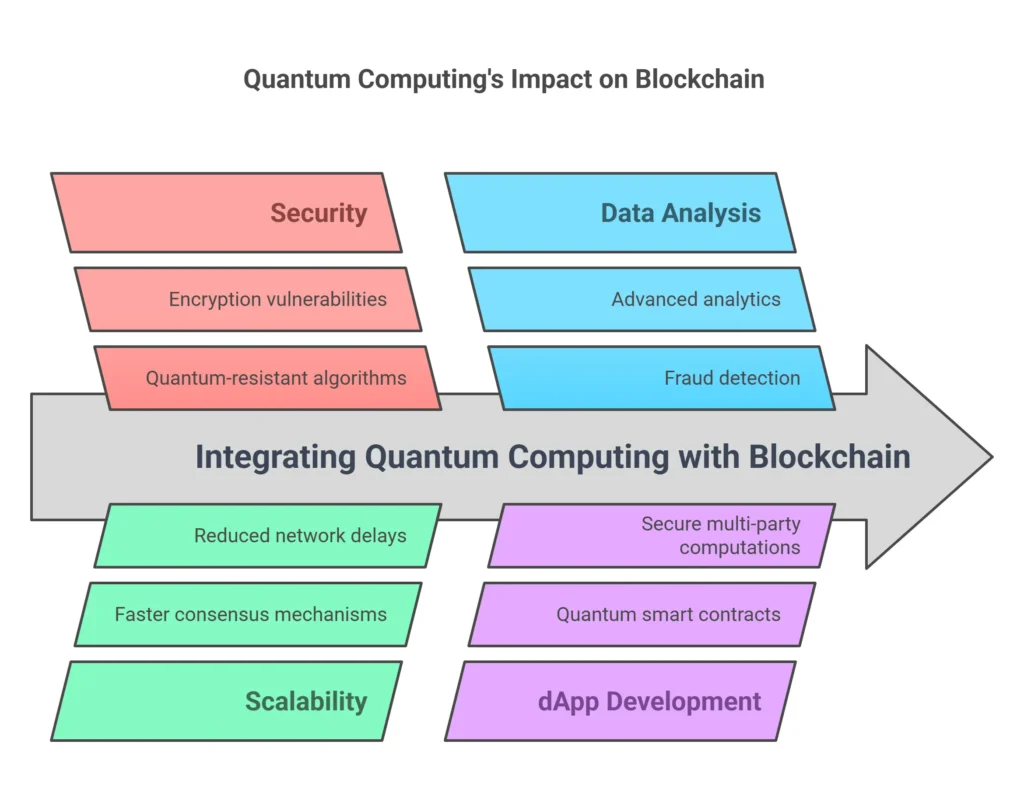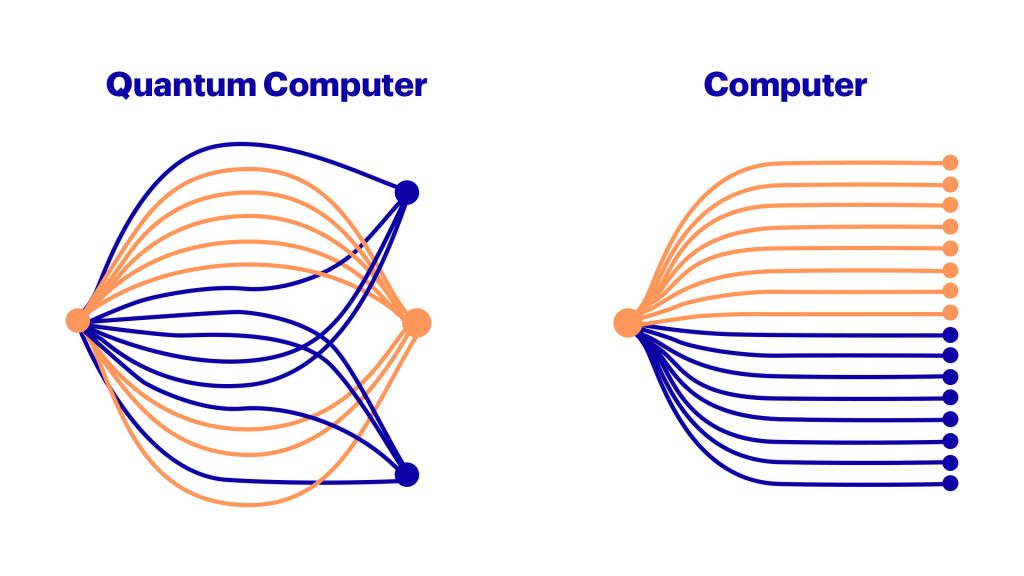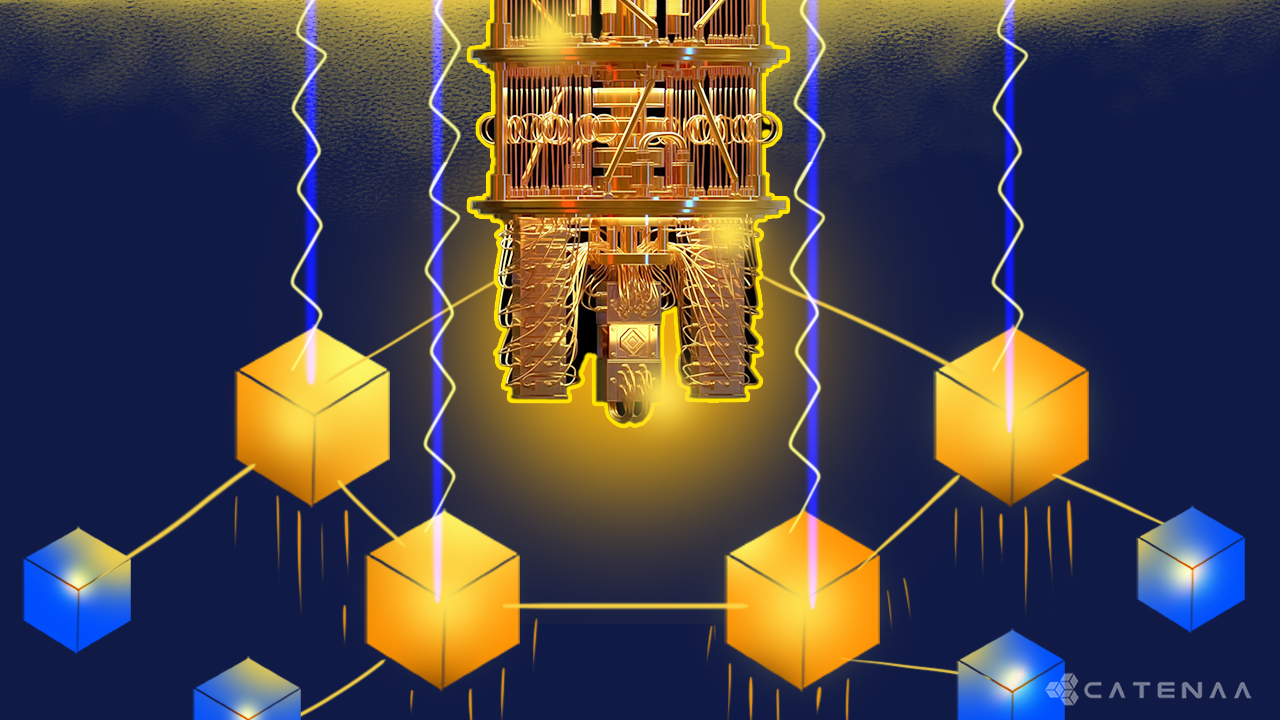What is Quantum Computing?
Quantum computing is an emerging technology that harnesses the laws of quantum mechanics in order to solve complex problems that classical computers cannot handle. Unlike the computers we use now, which use bits to represent data, quantum computers use quantum bits, also known as ‘qubits,’ to represent data. Due to a property known as ‘superposition,’ qubits are able to exist in multiple states at the same time. These unique characteristics of qubits allow quantum (PoW) computers to solve complex problems such as simulations of optimization tasks, complex physical systems, database searches, and cryptography. 1
How does Quantum computing apply to Blockchain?
Quantum computing will have a significant impact on the security landscape of blockchain. To begin with, The security of conventional blockchain networks could be compromised by quantum computers’ potential to decrypt existing methods of encryption.
However, equally quantum Blockchains can provide a higher level of resistance against quantum attacks ensuring the integrity and secrecy of transactions and data, by utilizing quantum-resistant cryptographic algorithms.
Another aspect of blockchain that can be enhanced by this integration is ‘scalability.’ Limited scalability is one of the main problems faced by existing blockchains and can be clearly seen in network delays and prolonged transaction processing times. Quantum computing has the potential to increase the scalability of blockchain networks and enable faster consensus procedures, allowing for the processing of multiple transactions in less time.
This integration will also enable advanced data analysis and pattern recognition. Using quantum algorithms, large amounts of blockchain data can be mined for insightful information, enabling more complex analytics, fraud detection, and anomaly detection. This can be very useful in fields such as banking, supply chain management, and healthcare, where real-time data analysis can promote effectiveness, transparency, and better decision-making processes.
Furthermore, decentralized apps (dApps) with improved functionalities, such as secure multi-party computations and quantum smart contracts, can also be created on quantum blockchains. Decentralized quantum simulations, quantum-secure multi-party financial transactions, and quantum-resistant digital identity systems are just a few examples of these cutting-edge features’ innovative use cases.

What is Quantum Compute PoW Consensus?

Recently, there has been an exciting development in the world of the Blockchain landscape, the introduction of Quantum Compute Proof of Work (QCPoW) consensus. The consensus mechanism called Quantum Compute PoW uses quantum computing to improve the efficiency and security of blockchain networks. In order to verify transactions and secure the blockchain, it attempts to use the processing power of quantum computers to solve challenging mathematical problems. The standard Proof of Work (PoW) consensus’s energy and computational problems are resolved by QCPoW, which also offers improved defense against 51% of attacks. Blockchain networks will significantly improve in speed and scalability thanks to QCPoW, allowing miners to solve difficult mathematical problems quickly.
Developments in QC PoW Consensus
An innovative proof-of-work (PoW) scheme for blockchain consensus that depends on quantum computing techniques to validate consensus was recently proposed by a group of researchers from universities in Australia and the United States, working in collaboration with the quantum technology company BTQ. According to the paper, the quantum advantage offered by this approach would also make mining more challenging, making it possible to “maintain consistent block mining time” as the number of miners increases and further encouraging continued participation of “quantum miners.” Additionally, researchers claim that it might be the ideal approach for future-proofing blockchain applications and possibly reducing the environmental impact of mining on the Bitcoin blockchain and related chains. 2 3
Comparing Classical vs. Quantum Computing for PoW Consensus Algorithms

Classical computing has long been the standard when it comes to Proof of Work (PoW) consensus algorithms. However, a new competitor has entered this space with the development of Quantum Compute Proof of Work (QCPoW) consensus. The difficult calculations needed for PoW consensus can be solved using both classical and quantum computers, although quantum computing has a clear speed and efficiency advantage. QCPoW can solve these problems significantly faster than a classical computer. As mentioned earlier, QCPoW is more resilient against 51% of attacks, making it more secure.
Introducing quantum computers into a PoW-based blockchain will consequently increase the total computational power a proof-of-work cryptocurrency network uses to process transactions, also known as the ‘Hash-rate.’ This will, therefore, shorten the average time it takes for the network to produce a block. It has been demonstrated that increasing the PoW difficulty parameter solidifies quantum computers’ quadratic mining advantage. More investment will be encouraged because the profit margins for quantum mining technologies will be higher than those for traditional mining technologies. With a greater incentive, more quantum miners will be on the network, reducing block time and increasing PoW difficulty. As traditional miners become unprofitable, a cycle develops in which quantum computing technology will eventually completely replace them. 4
The introduction of Quantum Compute Proof of Work (QCPoW) consensus offers a new and exciting alternative to classical computing for solving the complex mathematical problems required for blockchain-based Proof of Work consensus algorithms.
With its significant advantages in terms of speed, efficiency, and resistance to attacks, QCPoW has the potential to revolutionize the blockchain industry. As more breakthroughs in quantum computing are developed, it will be exciting to see how this technology continues to influence the development of new consensus algorithms for blockchain-based systems.
- www.mckinsey.com: www.mckinsey.com[↩]
- cointelegraph.com: cointelegraph.com[↩]
- insidequantumtechnology.com: Quantum News Briefs June 5[↩]
- ScienceDirect: www.sciencedirect.com[↩]


